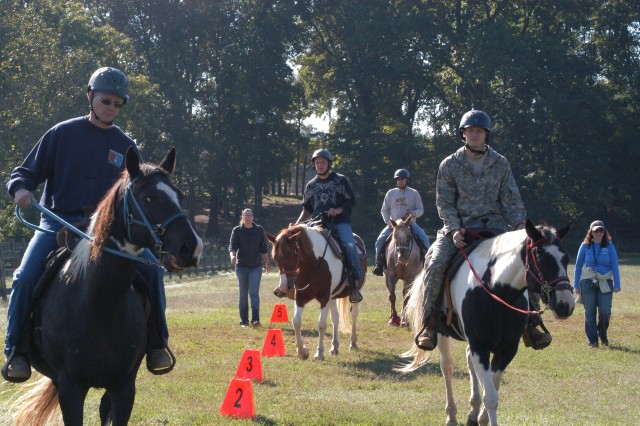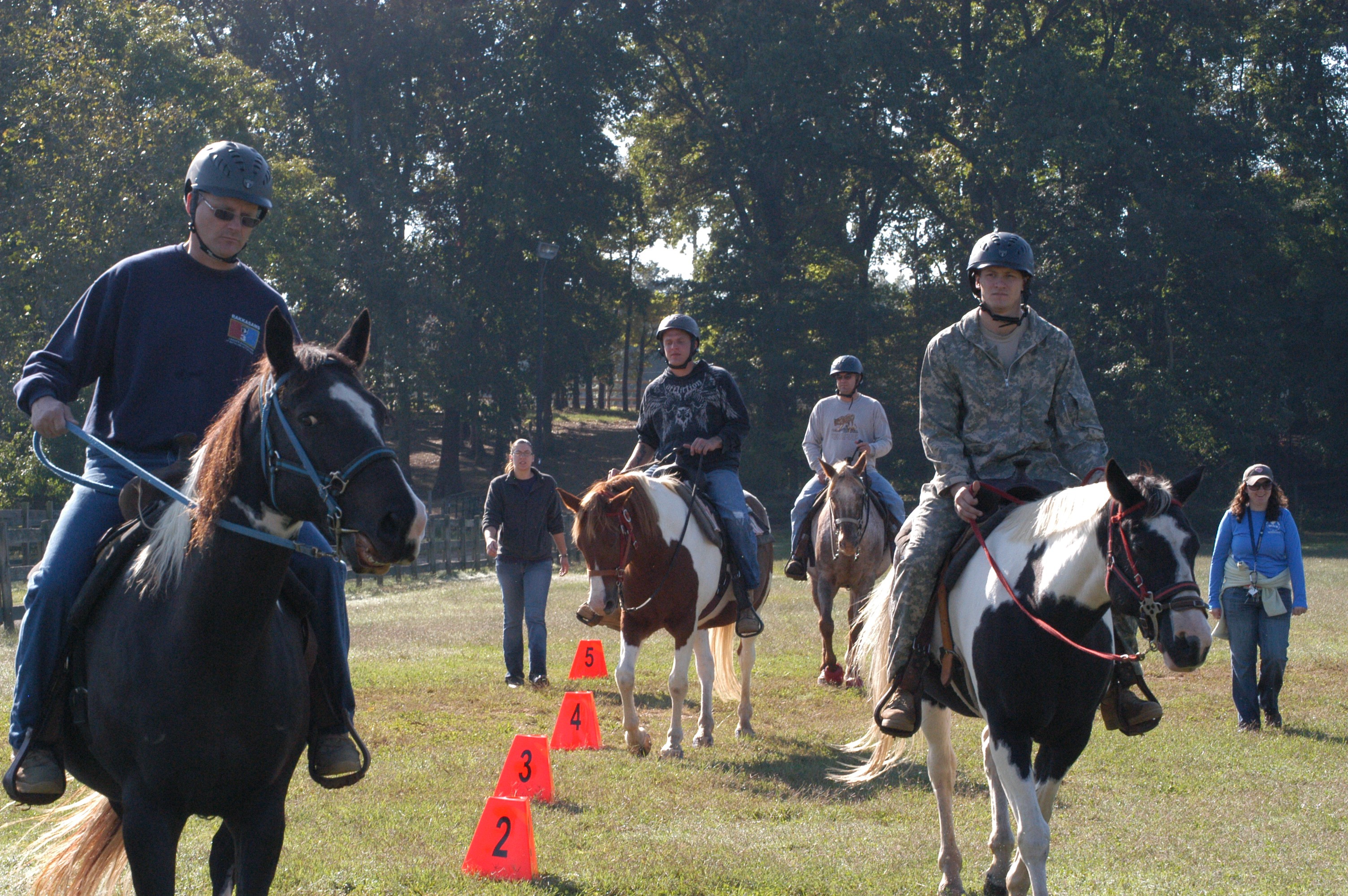Equine-assisted therapy is running along at a healthy pace at Fort Campbell. The benefits have been shown in using this dynamic form of treatment for Warrior Transition Battalion Soldiers, not only with physical, but psychological treatment needs.
Kristin Wilcox, Outdoor Recreation program manager, helped get the program off the ground after a test run in Springfield, Tenn., last year.
"The program provides different goals for each Soldier, whether it's stress relief or even just something to do with Families," Wilcox said. "But for many, it's alleviation from any kind of symptoms they have."
Therapy is administered at Fort Campbell Horse Stables where the team is equipped with the means to administer animal and patient care, merging the two for specific wounded Soldier needs.
Each Soldier receives treatment to re-acclimate them to their life before injury, depending on whether that means returning to full active duty or simply learning to cope with an injury or other traumatic event.
Time spent in the program depends on the severity of the injury or disability.
The traumatic brain injury clinic is typically a 12-week program that can include as many as five appointments a day. The clinic assists with symptoms that range from headaches, dizziness and poor balance to memory problems and light sensitivity.
Sergeant Matt Nagy, 506th Infantry Regiment, 4th Brigade Combat Team, 101st Airborne Division, is still with his unit, though not full time.
Nagy, who's in his third week of treatment, was physically injured by an IED in Afghanistan, sustaining a concussion and leg lacerations. Nagy hopes to be back to his unit full time by late November or early December.
One of the most difficult parts of treatment is coping with his migraine headaches, from which he suffers, he said.
"Another hard thing is trying to find something that will help [migraines], but they work well with you here, and really care about getting everybody well."
The program has allowed him to learn many good techniques to assist with his healing from injury, he said.
"The first couple of weeks were nerve-wracking, but over time, this is definitely stress relieving," he said. "Now I'm getting used to the horse and it's getting used to me."
"It definitely helps with balance and stress relief," he said.
How it works
During their time in treatment, Soldiers act as caretakers for their horse as part of their responsibility while they receive treatment.
Grooming is the first part of a patient's day every Wednesday and involves brushing the horse down, and cleaning under their shoes. The horses are then led to the riding area where exercises like obstacles and stretching are part of the routine.
A memorization aspect is integrated into the program as well, requiring wounded Soldiers to remember their horse, its name and color pattern.
Additionally, when the Soldier loads the horse's equipment and accessories, there's a name and number they have to coordinate. This process helps any short term or long term memory problems.
Once WTB Soldiers enter the riding area, taking the horses through numbered obstacles is part of the therapy that incorporates both physical and psychological therapy.
Even learning horse anatomy is infused into the treatment, while grooming serves as part of the behavioral health aspect.
Soldiers are assigned to work with the same horse for the entirety of the program unless there is a mismatch between personalities of the horse and Soldier or some injury to the horse.
The horses are assigned based on personality matches and over the course of therapy, build a bond with their caretaker.
"That always helps on the behavioral health side," said Dennis Russell, physical therapy technician, who oversees the medical side. "You can have the meanest horse here, and they actually help the person with the disability."
The horse's demeanor changes, shifting to accommodate the person. "Horses can sense a problem like anxiety," Russell said.
"They don't try to buck the rider, even though these same horses are used for trail riding on the weekends, and are not as cooperative then," Russell said.
Whereas mild traumatic brain injury might be treated at the clinic, Russell said for many of the wounded Soldiers the horse therapy program is perfect for moderate to severe injuries.
Horses can also help those with physical injuries by compensating their movements to the needs or impairments of the Soldier riding the horse.
According to www.equine-assistedtherapy.org, "Because the gait of a horse is similar to the human stride, this particular therapy strengthens and supports the natural motion of the spine and pelvis."
"If someone is riding, the horse can keep the person from falling off by adjusting how it moves," Russell said.
Recreation therapists, Jami Wikstrom and Wilcox are certified instructors that help the Soldiers with their therapy.
Wikstrom has been involved with therapeutic riding for about four years. "I enjoy giving back to those who give so much to us," Wikstrom said, "And seeing the positive results every week."
Therapy program value seen from top-down
Director of Outdoor Recreation, Aaron Goodman, calls the horse therapy an "invaluable program," and said that the program is not going anywhere.
"Our first focus is maintaining that program," Goodman said. "I will support it all the way to the top, until I hear otherwise."
Goodman said the program is a success due in part to the global network of collaboration that happens between all branches of service and among academic circles.
"People are learning and helping each other," Goodman said.
Wounded Soldier, Spc. Patrick Adams, 2nd Brigade Combat Team, 101st Airborne Division, said that it helps a lot to be able to associate with something.
"Fort Campbell is doing great with putting Soldiers back on their feet," Adams said. "I'm hoping to get back to working with my unit full force and giving it my all."
Adams said he's looking to return to his unit in November following injuries he sustained from explosions while he was in Iraq.
He's grown accustomed to his horse Missy. "She likes to be reassured, and is very loving," he said.
As for the future of the program, Wilcox is optimistic: "It's been a big success, since its start last October, she said. "It's still in its infancy, but we have lots of plans to grow and expand."




Social Sharing